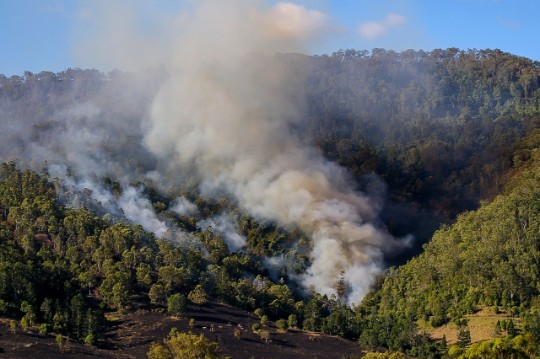A Cool Approach to Land Management

Researchers are collaborating with Indigenous people to understand the benefits of controlled ‘cool’ burning of bushland in natural hazard management.
Aboriginal and Torres Strait Islander peoples should be aware that this story contains the images and names of people who have passed away.
With unprecedented bushfires raging across southeastern Australia in the summer of 2019/20, Australians are all too aware of the continent’s intrinsic relationship with fire. Western Sydney University researcher, Dr Jessica Weir is documenting the cultural practices and intimate knowledge that Australian Aboriginal people have with fire in order to gain a better understanding of how to manage bushfires.
Weir has learned from her collaborative work that many Aboriginal people involved in land management engage with fire differently. Fire is understood to be central to living with and respecting Country.
Australia has always had large destructive bushfires, and for tens of thousands of years Aboriginal people have used ‘cool burns’ to mitigate their impact, as well as to assist plant growth, hunting, protecting species, and accessing areas.
Cool burns are distinct from prescribed burns, in that fires are lit not just for hazard reduction; a range of ecological and cultural considerations go into the choice of where, when and how to set the fire. These fires don’t destroy tree canopies, wildlife have time to escape, and by reducing fuel loads they can also protect lives and property from destructive ‘hot burn’ bushfires.
Working with fire on these terms can have local, regional and national benefits as a way to mitigate bushfire risk, create social-ecological spaces, and support Indigenous cultural practices and land management, including support for Indigenous rangers and firefighters.
However, carrying out cool burns presents many challenges, due to historical and contemporary land justice issues, and many conflicting interests vying for a stake in land management, from timber, to farmland, to mining.
“We’re very good at debating the science involved in land management, but we need to involve more research about our values, and that’s what we’re doing at the Institute for Culture and Society. We’re looking at what society thinks is normal and appropriate in bushfire risk mitigation,” says Weir.
COOL VS PRESCRIBED BURNS
The difference between cool burns, and prescribed or controlled burns is the intention and who is setting the fires. Cool or cultural burns are done by Indigenous people for a multitude of reasons including food, access and reduced bushfire risk; whereas hazard reduction burns are intended to reduce risk to properties and lives. Both require permission from relevant fire agencies.
Weir is co-leading a research project with Deakin University, with funding from the Bushfire and Natural Hazards Cooperative Research Centre, that examines the relationship between hazards, culture, and Indigenous communities.
One of several places where cool burns are influencing the fire sector is the Australian Capital Territory, where the ACT Parks and Conservation Service staff carry out a cultural burning program centred on learning from cool burns. “It’s about changing industry practices in the ACT,” says Weir.
In the ACT Parks and Conservation Service program, the Ngunnawal people, the traditional custodians of Canberra, identify priority areas and then a Ween Bidja (fire boss) lights the fire. “We call them ‘the fire boss’ because we are in control of the fire, it is not in control of us. Fire is a tool,” says Dean Freeman, a Wiradjuri man and Aboriginal Fire Officer from the ACT Parks and Conservation Service.
“You can imagine it was very exciting when we got an elder, Uncle Karl Brown, to light the first match in Canberra in an area which hadn’t been lit for 200 years. We are bringing our ancient techniques into the modern world. We also use it to protect our own cultural sites,” says Freeman.
“It’s extraordinary because it’s a community of practice. Indigenous and non-Indigenous fireys working on risk-mitigation together,” says Weir.
Weir’s qualitative research involves interviewing Indigenous and non-Indigenous government staff involved in the burns and tracking their different assumptions, knowledge and practices they bring to fire management.
Need to know
- Cool burns have been practised by Indigenous people for tens of thousands of years.
- The Bushfire and Natural Hazards CRC is investigating the relationships between hazards, culture, and Indigenous communities.
In public debates it is sometimes assumed that Aboriginal fire management and other traditions are set in the past and irrelevant to modern Australia. The interviews have revealed further understanding, that these are living traditions, always adapted to contemporary contexts, including bringing in new techniques and new knowledge. “This is a critical gear change in our maturity as a nation,” adds Weir.
Weir is exploring how reinstating cultural burning in Canberra can support Indigenous peoples’ cultural practices. “It’s an opportunity to showcase Indigenous peoples’ authority and care with respect to fire and the land.” The work has also revealed that if traditional owners are to lead their own fire management, a much greater sharing of land management resources is required.
She views the Canberra project as a success. Rather than being restricted by public sector bureaucracy, she says the ACT cultural burning programme has now entwined itself around the machinery of government in a way that accesses resources and is slowly but surely changing public sector practice.
“Ultimately, it’s about continuing to respectfully learn from each other about how to live best in Australia, and how to manage bushfire risk — which is only increasing.”
This case study is republished from Future-Makers. Read the original article (opens in a new window).
Partner with ICS
If you would like to collaborate with us or find out more about what we can offer you, please get in touch with our Senior Business Development Officer - Sally Byrnes - using the details below.
Email: S.Byrnes@westernsydney.edu.au
Phone: +61 421 320 441




